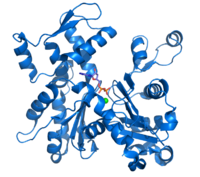
Photo from wikipedia
Summary The endosomal sorting complex required for transport-III (ESCRT-III) catalyzes membrane fission from within membrane necks, a process that is essential for many cellular functions, from cell division to lysosome… Click to show full abstract
Summary The endosomal sorting complex required for transport-III (ESCRT-III) catalyzes membrane fission from within membrane necks, a process that is essential for many cellular functions, from cell division to lysosome degradation and autophagy. How it breaks membranes, though, remains unknown. Here, we characterize a sequential polymerization of ESCRT-III subunits that, driven by a recruitment cascade and by continuous subunit-turnover powered by the ATPase Vps4, induces membrane deformation and fission. During this process, the exchange of Vps24 for Did2 induces a tilt in the polymer-membrane interface, which triggers transition from flat spiral polymers to helical filament to drive the formation of membrane protrusions, and ends with the formation of a highly constricted Did2-Ist1 co-polymer that we show is competent to promote fission when bound on the inside of membrane necks. Overall, our results suggest a mechanism of stepwise changes in ESCRT-III filament structure and mechanical properties via exchange of the filament subunits to catalyze ESCRT-III activity.
Journal Title: Cell
Year Published: 2020
Link to full text (if available)
Share on Social Media: Sign Up to like & get
recommendations!